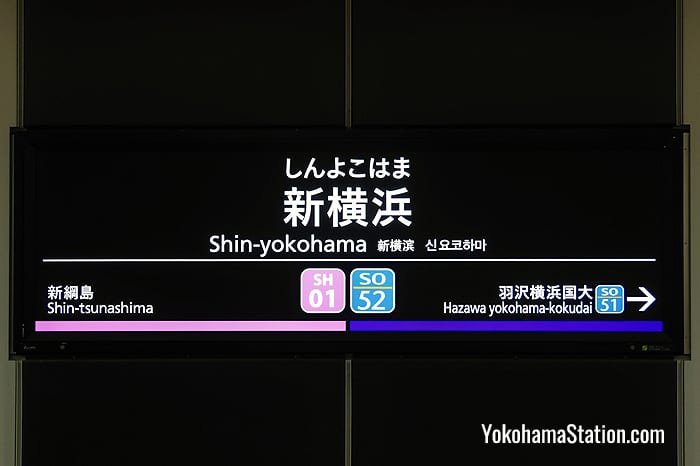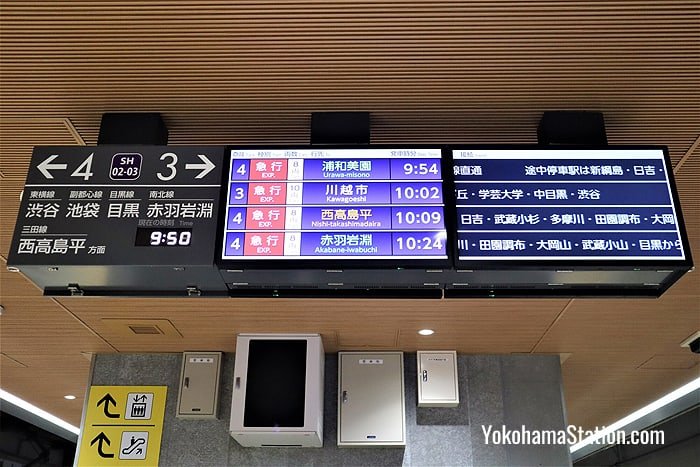The Shin-Yokohama Line is a link line in Yokohama that connects the railway networks of two private railway companies: Sotetsu (also called Sagami Railway) and Tokyu. The line is divided into two parts that meet at Shin-Yokohama Station.

A station name sign at Shin-Yokohama Station. Sotetsu stations are color-coded blue and Tokyu stations are color-coded pink
The Sotetsu Shin-Yokohama Line runs from south to north between Nishiya Station and Shin-Yokohama Station and the Tokyu Shin-Yokohama Line runs from south to north between Shin-Yokohama Station and Hiyoshi Station.
Through services from both railway companies run via the Shin-Yokohama Line onto each other’s networks. This makes it possible to take a train from Ebina on the Sotetsu Main Line or from Shonandai on the Sotetsu Izumino Line all the way to Shibuya on the Tokyu Toyoko Line or Meguro on the Tokyu Meguro Line.
This railway line opened on March 18, 2023, and has improved access to the shinkansen terminal at Shin-Yokohama Station as well as improving access between Yokohama and Tokyo. It is now possible to travel between Shin-Yokohama and Shibuya in just 25 minutes and between Shin-Yokohama and Meguro in just 23 minutes.

Departure information for Platforms 3 and 4 at Sotetsu & Tokyu Shin-Yokohama Station
Destinations
There are three stations on the Sotetsu Shin-Yokohama Line:
Nishiya – Hazawa Yokohama-Kokudai – Shin-Yokohama
And there are three stations on the Tokyu Shin-Yokohama Line:
Shin-Yokohama – Shin-Tsunashima – Hiyoshi
From Nishiya Station southbound through services continue on the Sotetsu Main Line. From Hiyoshi Station northbound through services continue on the Tokyu Toyoko Line or the Tokyu Meguro Line.
The stations on the Sotetsu and Tokyu parts of the line are listed below with example fares and journey times given from Shin-Yokohama Station.
Shin-Yokohama Station
Shin-Yokohama Station is the high-speed shinkansen terminal for the city of Yokohama. Exit here for Shin-Yokohama Ramen Museum, a popular attraction just five minutes on foot from Shin-Yokohama Station. The museum features a recreation of a Tokyo downtown district in the year 1958 and contains a food court with ramen noodle shops from all over Japan.
Transfer here to the Tokaido Shinkansen with services running to Nagoya, Kyoto and Osaka. Transfers can also be made here to the JR Yokohama Line for services running to Yokohama Station or Yokohama Municipal Subway’s Blue Line, which also runs to Yokohama Station, as well as Kannai Station in Yokohama’s main sightseeing area.
Sotetsu & Tokyu Shin-Yokohama Station is an underground station on the north side of the main station building. Southbound services for the Sotetsu railway network run from platforms 1 and 2 while northbound services for the Tokyu railway network run from platforms 3 and 4.
Sotetsu Stations
Hazawa Yokohama-Kokudai Station
Transfer here to Sotetsu-JR Link Line services bound for Osaki Station and Shinjuku Station on the JR Saikyo Line.
Train fare: 230 yen
Train time: 3 minutes
Nishiya Station
Beyond Nishiya Station through services either continue on the Sotetsu Main Line all the way to Ebina Station or join the Sotetsu Izumino Line at Futamatagawa Station and continue on to Shonandai Station.
Transfer at Nishiya Station to Sotetsu Main Line services bound for Hoshikawa Station and Yokohama Station.
Train fare: 260 yen
Train time: 7 minutes
Tokyu Stations
Shin-Tsunashima Station
Shin-Tsunashima Station is a 2-minute walk from Tsunashima Station on the Tokyu Toyoko Line, however, the two stations are not directly connected.
Train fare: 250 yen
Train time: 3 minutes
Hiyoshi Station
This station is convenient for the Hiyoshi Campus of Keio University. Beyond Hiyoshi Station through services either continue on the Tokyu Toyoko Line to Shibuya Station or the Tokyu Meguro Line to Meguro Station.
Transfer at Hiyoshi Station for Tokyu Toyoko Line services bound for Kikuna Station or Yokohama Station. Transfers can also be made here to Yokohama Municipal Subway’s Green Line.
Train fare: 250 yen
Train time: 7 minutes
Useful Links
For more information on the different lines of the Sotetsu and Tokyu railway networks please visit the official Sotetsu website and Tokyu website. To plan a journey on these networks, we recommend English language route planners like Hyperdia or the Japan Transit Planner.
Article by Michael Lambe. Photos by KUZUHA/pixta (1), skyyokohama/pixta (2). All rights reserved.
